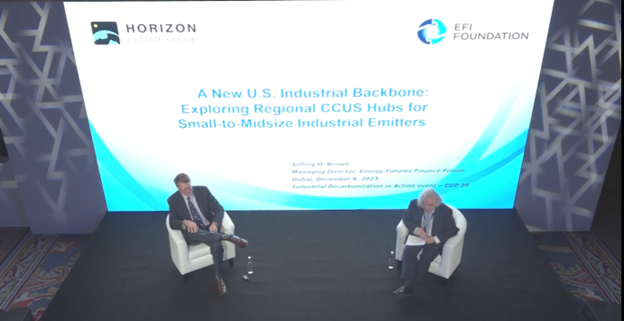
This piece is part of one of several covering thought leadership from Ernest Moniz at COP28 in December 2023 in Dubai, United Arab Emirates. It was originally posted on May 7, 2024, but it is now in chronological order of when the event occurred.
EFI Foundation (EFIF) CEO Ernest Moniz and Jeffrey Brown, managing director EFIF’s Energy Futures Finance Forum (EF3), spoke at an event hosted by study sponsor Carbon Clean at COP28 on December 6, 2023. The event rolled out an EFI Foundation study on reducing the carbon dioxide (CO2) emissions of small-to-midsize emitters in the United States.
The study was co-authored by Horizon Climate Group and sponsored by Carbon Clean. It focused on how to reduce industrial emissions of CO2 by grouping small and midsize industrial emitters in regional hubs with access to carbon capture, utilization, and storage (CCUS) infrastructure. These emitters account for 25% of U.S. industrial emissions.
The study screened data on all U.S. industrial emitters to identify 10 potential regional clusters of small-to-midsize facilities close enough to form a hub. The 10 potential clusters include 1,000 facilities with total annual emissions of 111 million metric tons per year—more than the annual CO2 emissions of Washington state in 2019.
“We’re excited about [CCUS hubs],” Moniz said. “This looks like a very interesting pathway to address an important problem.”
New contributions
Moniz said this study came at a pivotal moment, following the passage of “some very good decarbonization incentives” in recent federal climate legislation: the Bipartisan Infrastructure Law, CHIPS and Science Act, and the Inflation Reduction Act.
“Bottom line—it was really time to do this study,” Moniz said.
Brown said this study differs from prior research on industrial decarbonization because it focuses on small-to-midsize emitters. These emitters are a segment of the market that experts usually screen out so they can pursue the task of curbing emissions from large emitters instead.
According to the study, experts have prioritized large emitters because they tend to capture enough CO2 to make investment in transport and storage infrastructure technologically and economically feasible. Small-to-midsize emitters historically have not, but this is beginning to change with technological innovations related to carbon capture.
Brown said another special characteristic of this study was analyzing the potential for small-to-midsize industrial facilities to reduce CO2 emissions from their individual chimneys—or stacks. He said that the main challenge is assembling enough of these stacks to make geological sequestration affordable because transportation and investment in permitting and development currently constitute “considerable upfront costs.”
Scaling challenges
The study highlighted how CCUS hubs are important for small-to-midsize emitters because they reduce the costs associated with getting started while increasing the amount of CO2 stored. Multiple projects in the same region can share transportation and storage infrastructure and pursue pre-operational activities—such as permitting, community engagement, and regulatory compliance—through a centralized process.
Moniz said that scaling challenges are still very real. CCUS tends to be prohibitively expensive for smaller industrial facilities.
“As you scale down, you can have costs scaling up,” Moniz explained. “We think that needs reexamination.”
In the study, the EFI Foundation recommends expanding the direct pay and transferability options of the 45Q Tax Credit in the Inflation Reduction Act to help address scaling challenges. These improvements would help small-to-midsize emitters turn the credit into money.
However, according to the study, expanding the 45Q Tax Credit alone may not be enough. The government could use the CarbonSAFE authority, which is run by the National Energy Technology Laboratory at the U.S. Department of Energy, to provide funding that could help spur large-scale CCUS hub development.
Legislative support
Moniz and Brown discussed how federal and state legislation could help establish regional CCUS hubs.
Brown emphasized the need for federal and state governments to streamline permitting for CCUS hubs, as with other clean energy projects. He also suggested that Congress develop a model for carbon sequestration as a public good, similar to the electric utility model.
“If I build an industry in town, I typically don’t have to build my own sewer line in my own waste processing plant,” Brown said; carbon sequestration is a similar public service that the government should provide.
Moniz explained that creating regional CCUS hubs would go more smoothly if the Bipartisan Infrastructure Law, CHIPs and Science Act, and Inflation Reduction Act were implemented in a way in which they could work in concert with each other.
“Congress passed them as three separate bills, with no idea of integration and how they work together,” Moniz said. “We need a more integrated look.”
He said that with the right legislative underpinnings, the United States could establish a market for CO2 from CCUS hubs.
“Is there a potential market for this?” Moniz said. “The answer is yes, and we should pursue it.”
– Georgia Lyon, Communications Associate
(Share this post with others.)




